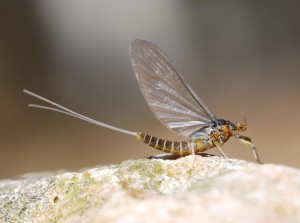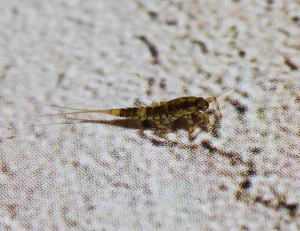February 12, 2012
By Paul Weamer

It's been a warmer than average winter, and nature's creatures notice things like that. Winter birds, which normally flock to the feeder in front of my house, have remained strangely absent this year, until last night's cold-snap and miniature blizzard brought them out in force this morning. The snow-free countryside had made natural food more available to the birds, so, until now, they weren't interested in seeds from a bag. And another sign of an unusually mild winter has recently appeared: reports of a few Little Blue Winged Olives began trickling into the fly shop a little more than a week ago.
For many trout, Baetis are the first and last mayfly hatch they see each year. The Baetis hatch connects the seasons; the one that ended last fall and the one that is about to begin. They remind me of a great October fishing trip last year when trout came easily to my net from water peppered by the occasional ruby-colored leaf. The fish weren't eating dries that day. But a tandem of size 18 pheasant tails, slowly stripped like a wintertime streamer, evoked strikes from wild browns that believed they were eating one of the many Baetis nymphs I could see moving to resting areas behind boulders, preparing to emerge. Perhaps it was those very flies that gave birth to the Baetis the anglers in my shop are seeing this year.
The central Pennsylvania spring creeks, which ooze from the karst geology beneath local valley floors, maintain water temperatures much warmer in the winter than the freestone streams that tumble out of the nearby Appalachian Mountains. This means that during an average winter, anglers will find Baetis in our brown trout streams well before the possibility of mayfly hatches exist for most brook trout. Mid February Baetis emergences, though not common, occur from time to time in Central Pennsylvania. But early February hatches are much less common. Whether this phenomenon is caused by an increasingly warming planet, or by the the new-to-me weather contributor known as the Arctic Oscillation, is left to be determined by those smarter than I am. But the bugs aren't interested in why. They are simply here.
The hatch hasn't really revealed itself, yet. It's still in a junior high school stage with a few advanced members developing ahead of the others. A quick examination of stream-bottom rocks shows that most of the flies are just not ready. Look at the Baetis nymph in the photograph below:

I shot this photo earlier this week. This nymph's wing-pads will transform from its current mottled-olive color to dark brown, near black, as the dun develops beneath its exoskeleton. Then this Baetis will hatch. When many begin to hatch, the trout will notice, and after the trout notice, they will begin to eat them in the slow pools. And then, no matter what the calendar says, another spring has arrived for fly fishers.
